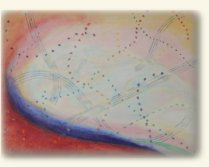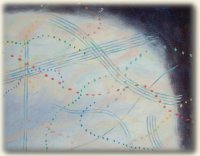Voice Texture
►
►
►
►
►

So just, so small,
yet in so sweet a note,
it seem'd the music
melted in the throat.
-John Dryen
Like fabric, voices have texture. Imagine touching cool, smooth satin. Now imagine a voice that is clear and cool, yet slippery and swirling around you. Likewise, imagine touching thick silk velvet. Feeling the warm, deep, soft, pile prompts feelings of decadence. When you hear a velvet voice, your response is the same. You melt in the luxury of the sound.
Do you wonder what your vocal texture might be?
Vocal texture is determined by genetics and by choice. Here are some aspects of voice texture:
Would style and genre of music affect texture? Certainly. People can make all sorts of sounds, especially character voices, take Donald Duck or Bart Simpson for examples. However, there are two constants. One is the particular timbre (non-mobile structures) which identifies you as you! The other which should stay a constant is the technique in which you engage your vocal apparatus.

Nine-tenths of wisdom is being wise in time.
-Theodore Roosevelt
Releasing all unnecessary muscle tension while you sing (or play any other wind instrument) allows more resonance to happen. Plus, it makes the whole experience of sound production more pleasurable to the performer as well as the audience.
- Alexander technique - Lessons are taught privately by trained technicians. There is also a DVD about the technique with exercises to do.
- Feldenkrais - Feldenkrais was a student of Alexander and developed a way to have the student learn by themselves with instructional guidance. Feldenkrais workshops are available on YouTube.
- Center chi - You can use the Asian idea of the center of your body where your energy is centered, focused, and concentrated as a mental "distraction" to allow the release of unnecessary tension. Your center is located at the intersection of three planes. The first plane divides you in half down your nose, the second from your ears, and the third at half your height.
Skull - the shape and size of your skull affects the timbre of your sound.
Sinus cavities - the size, position and status of your sinuses affect the sonority of the sound you produce.
Mouth - How big your mouth cavity is affects sound. Is your mouth more parabolic or more 'U' shaped? Even your teeth are resonators.
Chest cavities - any open space in your chest area affects your sound. The more open, the more the resonance. So, keep your ribs lifted.
Sternum - this is a main vibration plate. When another singer or recorder player is making a sound directly across from me, I feel it in my sternum. Especially when the pitch starts to pull away, the sound waves are most energized against my sternum. I feel my own sound waves as well as those coming at me. Give it a try, be very relaxed and see what you feel.
The skillful shaping of each consonant and vowel affects the quality and purity of sound. The categories below are a sample of elements that are changeable. The examples do not state what is correct or not in singing, just elements to play with.
- Shape of lips - do your lips open up wider than taller? Do you hold your lips against your teeth or lifted away? Are your lips tight or relaxed?
- Cheeks - relaxed or pulled back?
- Soft palate - lifted or flat?
- Nasal passage - open or closed off?
- Tongue position - The tongue has a myriad of positions. How well do you know exactly what your tongue is doing and where you want the tongue to be? Plus there is the back of the tongue, the middle and the tip. The tongue is a study unto itself. The tongue is a tricky, powerful muscle requiring isolated training.
- Jaw - tense or relaxed? Narrow or dropped?
- Air passage - all of the above situations shape the total air flow and results in a specific vowel sound.
CONTACT
Please email me if you are interested in lessons.
My email is my first name, brigitte, spelled with 2 i's and no D, followed by @singersheart.com
I look forward to hearing from you!
